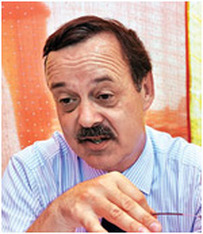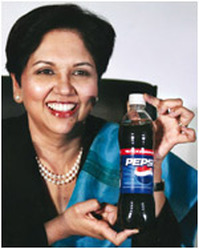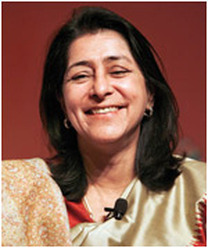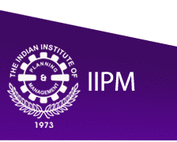While the 4Ps b&M list of india’s most valuable brands celebrates stardom, there are others who need encouragement for the promise and potential they have. 4Ps b&M handpicks a few of them who have dared to take on the market challenges and may make it big in coming times. here’s a quick look...
ARIHANT SUPERSTRUCTURES LTDA leading realtor from Mumbai, Arihant Group is known for their key role in transforming Navi Mumbai’s skyline. The almost 25-year old company is known for its passion for adhering to promised timelines. The realty major is expanding at a rapid pace today with a slew of projects coming in various parts of the country including the National Capital Region (NCR). Arihant’s ambitions are evident in the fact that it was ranked 161 in 400 small cap companies by Dalal Street last year. The vision of the company is to grow consistently at around 50% over the next five to seven years. PitambariIf you understand the Indian consumer’s mindset, rest assured that your consumer goods brand will grow. That is indeed the case with Pitambari Products Pvt. Ltd., which has been in the business of consumer brands ranging from home care and health care to agri-care and health for over two decades. This home-grown brand has gradually become one of the trusted names among consumer products available at affordable prices in India. Founded by Ravindara Prabhudesai, the ISO 9001:2001 certified company has five manufacturing units across the country and operates in 19 different states boasting a consumer segment comprising nearly three million users. Asian Granito India Ltd.Established in the year 2000, Asian Granito India Ltd. (AGIL) has emerged as a Rs.700 crore giant in the Indian space décor industry and is moving forward as one of the fastest growing ceramic companies in the segment today. AGIL aims to “lead the change” through its first mover advantage. To capitalise on the same, the company last year launched ‘digital polished vitrified tiles’ in India, bringing a revolution to the market segment. The flooring accommodates digital printing and substitute natural marble by providing hassles free installation. Sangam SuitingsIn the present day ultra-competitve market it’s tough for companies to provide quality and maintain it all along. But that has been the core value that drives Sangam Suitings. Since inception in 1985, the company has worked at bringing value to their customers by providing quality products through superior raw material and better finishing of for fabrics and using. Buoyed by its success, the company is now set to enter the ready to wear market later this year and hopes to create the same magic in this segment. It aims to prove that a quality product need not necessarily be expensive. UnIglobe Keshav TravelTechnology is making travellers more informed than ever. They expect the very best wherever they go and whatever they do. Small surprise that the tour & travel industry is becoming more demanding by the day. And there are a few names, including Uniglobe Keshav Travel, which have been living up to these high consumer expectations. The decade old company, affiliated to the world’s largest single brand travel network Uniglobe Travel, boasts of a network comprising more than 700 locations worldwide. Focussed on savings and service, their tech-enabled service efficiencies have given them a slew of happy clients - both corporate & leisure. Kesari toursA lot of emotions are at stake when people travel. In an industry where customer service plays a larger-than-life role, Kesari Tours has ensured that it delivers its best every time. Known for their innovations, the Kesari group, which started operations way back in 1984, is well respected for its ‘hold on’ group tours. This offers something or the other to every traveler in the group depending on budget and preference. Perhaps this is one of the main driving behind high customer loyalty that they enjoy. For more articles, Click on IIPM ArticleSource : IIPM Editorial, 2013 An Initiative of IIPM, Malay Chaudhuri and Arindam chaudhuri ( Renowned Management Guru and Economist). For More IIPM Info, Visit below mentioned LinksSC slams AICTE's illicit control on MBA coursesMBA, MCA courses no longer under AICTE 2012 : DNA National B-School Survey 2012
Ranked 1st in International Exposure (ahead of all the IIMs)
Ranked 6th OverallZee Business Best B-School Survey 2012 Prof. Arindam Chaudhuri’s Session at IMA IndoreIIPM IN FINANCIAL TIMES, UK. FEATURE OF THE WEEK IIPM strong hold on Placement : 10000 Students Placed in last 5 yearIIPM’s Management Consulting Arm-Planman ConsultingProfessor Arindam Chaudhuri – A Man For The Society….IIPM: Indian Institute of Planning and ManagementIIPM makes business education truly global
Management Guru Arindam Chaudhuri
Rajita Chaudhuri-The New Age Woman
IIPM B-School Facebook Page
IIPM Global Exposure
IIPM Best B School India
IIPM B-School Detail IIPM LinksIIPM : The B-School with a Human Face-----------------------------------------------------------------------------------------------------------------
Harjot Singh, Narang Branch Head, Dentsu Marcom
What mandate were you given when you joined Dentsu?These were Rohit’s exact words when I met him for this position, “Build an agency, which is solid, sustainable and admirable.” None of this was about profitability. He never gave me a profit or a number target. The objective was to create an agency that is sustainable and charged up so that it automatically delivers better than anyone else that the client could choose. You lay a lot of emphasis on hiring the right people. But how do you put that into action?We don’t hire people who live in a uni-dimensional area or in a clichéd area. You pick and choose what you want and then strengthen the teams to run independently. We allow them to make mistakes but also to learn and to keep the attitude of “I just have to do it”. Moreover we have devised simple brainstorming techniques. For example as a rule, the first ten ideas you put down on a piece of paper are all the clichés coming out of your head, so those get rejected immediately. Between the 11th to 15th idea, something nice can come out. And if you can reach between the 15th and 18th idea, you surely have something great. Nobody has ever been able to fly a plane or run a ship with a single push. You need to keep pushing hard to get the wheels moving. For more articles, Click on IIPM ArticleSource : IIPM Editorial, 2013 An Initiative of IIPM, Malay Chaudhuri and Arindam chaudhuri ( Renowned Management Guru and Economist). For More IIPM Info, Visit below mentioned Links 2012 : DNA National B-School Survey 2012
Ranked 1st in International Exposure (ahead of all the IIMs)
Ranked 6th Overall Zee Business Best B-School Survey 2012 Prof. Arindam Chaudhuri’s Session at IMA Indore IIPM IN FINANCIAL TIMES, UK. FEATURE OF THE WEEK IIPM strong hold on Placement : 10000 Students Placed in last 5 year IIPM’s Management Consulting Arm-Planman Consulting Professor Arindam Chaudhuri – A Man For The Society…. IIPM: Indian Institute of Planning and Management IIPM makes business education truly global Management Guru Arindam Chaudhuri Rajita Chaudhuri-The New Age Woman
IIPM B-School Facebook Page
IIPM Global Exposure
IIPM Best B School India
IIPM B-School Detail IIPM Links IIPM : The B-School with a Human Face IIPM – FLP (Flexi Learning Program)IIPM : The B-School with a Human FaceIIPM makes business education truly globalIIPM B-School Facebook Page IIPM Global ExposurePlanman Technologies
IIPM B-School Detail
IIPM: Selection Process
IIPM: Research and Publications
IIPM MBA Institute India
IIPM Contact Info
IIPM History
IIPM Think Tank
IIPM Infrastructure
IIPM Info
An Ad is a product of painstaking craftsmanship. Various elements, ranging from positioning of the product, clarity of the idea behind the product to visibility of the brand, its persona and the power of communication have to be intelligently weaved together. But while some ads manage to rewrite preset creative benchmarks, some go the wrong way, fall by the side & fail to excite viewers. In this section, we review three Ads that came out tops, for the right and the wrong reasons this fortnight.
smart-asses or cheaters?
Advertiser: Pepsi IndiaBaseline: Mauke Pe ChaukaAgency: JWT4Ps B&M Take: Pepsi has come up with a new twist to its ‘Change the Game’ brand campaign this summer and they are calling it ‘Mauke Pe Chauka’. This time they have introduced a football based TVC for the first time in India. But the cricket is not far behind - with Dhoni, Virat Kohli, Suresh Raina and Harbhajan Singh playing ‘stars’ in this film yet again against Chelsea’s Didier Drogba, Fernando Torres and Frank Lampard. So the three footballers enter the grounds and one of them picks up a bottle of Pepsi. Kohli, Bhajji and Raina – who are sitting poised as if to guard every bottle – take back the bottle saying that if the Chelsea guys want Pepsi, they had better play ‘our’ game – obviously cricket. Then ensues some amazing footwork by Drogba, Torres and Lampard – who volley the ball towards the stump and eventually dismiss Kohli. But Dhoni – who plays wicket keeper – suddenly raises his head and says ‘No Ball’. Of course, the footballers are flummoxed and ask him the meaning of the term. Dhoni says: ‘No ball, means no Pepsi’ and the cricketers burst out laughing. Why? Please don’t ask us. The challenge apparently was for the footballers to play the game – and not win it – in order to earn the Pepsi. And if the cricketers were supposed to look smart for tricking the Chelsea players out of their bottle of Pepsi – they didn’t! This is not to say that the ad itself is a washout. It’s not. Leave the cut and paste job that comes out (clearly, Drogba, Torres and Lampard’s scenes were shot somewhere else and pasted on the Indian scenes), it’s a nice attempt at combining two sports (and respective celebrities) that the Indian youth may idolize. In other words, if only brand recall was the objective of Pepsi, then they’ll more or less succeed in their attempt if the ad is repeated ad nauseum. For everything else, there’s Mastercard... Compare at your own risk
Advertiser: Nokia LumiaBaseline: Blown Away by Lumia4Ps B&M Take: Nokia seems to be running out of ideas to promote its new Lumia smartphone. In the latest campaign, an all dolled up Priyanka Chopra throws a challenge to another girl to verify if there is any smartphone which can compete with her Nokia Lumia 800 and win. The race is to update the word ‘challenge’ on both Facebook and Twitter simultaneously to establish which of their smartphones upload faster. But come on. Does it really matter? If you are habituated to your phone, have good connectivity and quality apps – any smartphone can do that job for you. Anyway, the girl obviously comes in second with Piggy Chops beating her to the task on hand. QED: Nokia Lumia 800 is ‘faster’ than any other smartphone in the world. Even the storyboard is a throwback to the ‘Surf ki kharidari mein hi samajdhari hai’ Lalitaji days. Hardly smacks of any ingenious bursts of creativity. Comparative advertising is good. It has also worked well for some brands in the past. Remember Complan and Horlics, Rin and Tide? But wake up guys. This is the 21st century. 24x7 influx of media has made consumers so cynical that they even read ‘’news’ with a pinch of salt. Blatantly comparative ads like this one may get you the temporary eyeballs – perhaps even a few ‘lucky’ trial consumers – but they’re not going to ever get you frenzied sales of the iPhone variety. For more articles, Click on IIPM ArticleSource : IIPM Editorial, 2012 An Initiative of IIPM, Malay Chaudhuri and Arindam chaudhuri ( Renowned Management Guru and Economist). For More IIPM Info, Visit below mentioned IIPM articles.
IIPM ranked No 1 B-School in India
domain-b.com : IIPM ranked ahead of IIMs
IIPM: Management Education India
Prof. Rajita Chaudhuri's Website
IIPM in sync with the best of the business world.......
Arindam Chaudhuri on Internet.....
Arindam Chaudhuri: We need Hazare's leadership
Professor Arindam Chaudhuri - A Man For The Society....
IIPM: Indian Institute of Planning and Management
Planman Technologies
IIPM Contact Info
IIPM History
IIPM Think Tank
IIPM Infrastructure
IIPM Info
IIPM: Selection Process
IIPM: Research and Publications
IIPM MBA Institute India
IIPM Best B School India--------------------------------------------------------------------------------------------------------------------------
Take this seat-of-the-pants brand quiz. Which event has the hallmark brand of five intertwined circles? Which company is represented by a half-bitten apple? If you were to see ‘__Inside’, what name would be the first to hit across your minds? Or if you came across ‘__with a hole’, which mint-product would you remember? Brand names have been key to ensuring that products have gotten converted from simple physical entities into billion dollar spawning businesses. Developing unique brand identities and logos have been key to competitive leadership and market superiority – the reason why customers, say, might choose a Louis Vuitton instead of a Louis Philippe. Now consider this – here is a logo that’s circular in shape with the front shot of a steam engine well-equipped with the signature cow-catcher bovine guard as the centre-piece and the national emblem at the front that aims to convey a sense of national comfort. Obviously, Indian Railways, one of the largest behemoths amongst the government-run units didn’t suffer too many pangs of creativity while creating its original logo, one guesses. Now, give yourself one final test. When was the last time you bought an Indian Railways ticket purely because you were impressed by the brand identity and its logo? We know the answer – never! Not that anybody was too impressed with the logo of Indian Railways earlier, but suddenly, the Railways has decided that it’s time they changed their logo! A nationally released advertisement invited the public by asking them to participate in the competition (of creating a new logo). The blink-and-you’ll-miss-it advertisement (you don’t remember seeing it, right?) also exhorted the participants with a cash prize of Rs. 5 lakhs for the winning entry. But does it really make sense for the Railways to go for a logo change, when customers make no differential about the Railways based on the brand logo (but more by the price, reach and the quality of services offered). Shouldn’t Indian Railways then be working more towards making their strategic processes more efficient than towards branding, especially in a monopoly-like situation where there’s possible no competitor? An Indian Railways source shares with 4Ps B&M, “Railways is going for a logo change because of the competition that it is facing from the low-cost airlines. However, having said that, the kind of connectivity that Railways has vis-à-vis Indian roads is still immaculate.” Jehangir S. Pocha, Co-founder INX News, confirms the viewpoint to 4Ps B&M, “A logo change definitely conveys a very strong change that often an organization might require to convey.” For more articles, Click on IIPM Article.Source : IIPM Editorial, 2010. An Initiative of IIPM, Malay Chaudhuri and Arindam chaudhuri ( Renowned Management Guru and Economist). For More IIPM Info, Visit below mentioned IIPM articles.
IIPM B-School Detail
IIPM makes business education truly global
IIPM’s Management Consulting Arm - Planman Consulting
Arindam Chaudhuri (IIPM Dean) – ‘Every human being is a diamond’
Arindam Chaudhuri – Everything is not in our hands
Planman Technologies – IT Solutions at your finger tips
Planman Consulting
Arindam Chaudhuri's Portfolio - he is at his candid best by Society Magazine
IIPM ranked No 1 B-School in India
domain-b.com : IIPM ranked ahead of IIMs
IIPM: Management Education India
Prof. Rajita Chaudhuri's Website---------------------------------------------------------------------------------------------------------------
 Jean Noel Bironneau, MD, Carrefour India
Precisely one year later since Bentonville Retailer Walmart opened its first wholesale cash-and-carry store in Amritsar (christened as Best Price Modern Wholesale) in a joint venture with Bharti enterprises, the world’s second largest retailer, France-based Carrefour announced that it would launch its first Cash & Carry outlet at Seelampur in Delhi in the next two-three months. With Germany’s Metro already operating in the Indian market since 2001, Carrefour is the third foreign player to set its foot into the C&C space. While Metro is still unable to hold a firm ground in the Indian market and is struggling with its venture, Walmart on the other hand has so far been successful in partnering with resellers, retailers and horecas (hotels, restaurants and catering sector). Eyes are now set on which way Carrefour heads – the Metro way or the Walmart way. Carrefour’s Delhi C&C store will cover an area of 55,000 sq. feet and house close to 30,000 SKUs, 90% of which will be sourced from India. Just like Walmart’s recent announcement of making India its global export hub, Carrefour too is currently sourcing goods worth $150-170 million for its international operations. Metro failed in the Indian market primarily because it could not sustain low prices given the high cost of infrastructure. On the face of it, Carrefour’s strategy is quite similar to that of Walmart’s. With Britain’s Tesco coming in a JV with Tata’s Trent by the year-end, the action has started.
 What is it about the Cannes Film Festival that the entire Indian film and fashion fraternity goes berserk about? Agreed that it is one of the world’s oldest and most prestigious film festivals, but unfortunately it has been reduced to an elongated event devoid of major celebrities. Worse, Cannes opening events and showcase screenings have now become the sauntering joints of the had-beens rather than the now and present – leave the likes of Aishwarya Rai, who looks as dazzlingly stunning as possible. Talking about that, even the Indian representation slips in Cannes. Unlike last year, when the entire spotlight was on Slumdog Millionaire (which, anyway, was a Brit-flick), in the ongoing 63rd Cannes Film Festival, the tally of Indian films is less than impressive with Anurag Kashyap’s Udaan being the only ‘Official Selection’ in the ‘Un Certain Regard’ category at Cannes. However, other film festivals like the San Francisco International Film Festival (held in February 2010 with 12 Indian films participating), Belgrade International Film Festival (showcased Gulaal, Dev.D and Delhi 6), the Phuket Film Festival (to be held in June 2010 and will screen Harishchchandrachi Factory, 3 Idiots and Chandni Chowk to China), et al, are stealing the show. It’s time Cannes retrospects on whether the low attendance was because of the volcanic ash syndrome or because people simply have grown weary of the affair. For evidence, compare the high profile attendance at the opening ceremony of the Oscars with what happens here.
 PepsiCo and AB-InBev’s media buying deal in US is said to aim at cost cuts but the threat of others following a similar route might make US media reject it completely
The town of Hoegaarden (pronounced ‘whogarden’) in the Flanders region of Belgium, named much earlier, is virtually a namesake to the iconic spiced wheat or “white” beers produced there since medieval times. The industry, a sacred tradition in Hoegaarden and the biggest employer in town, flourished for over 6 centuries. But in 2005, InBev, the world’s largest brewer and Hoegaarden’s owner since 1985, decided to close down HoeGaarden Brewery forever. But the quick buck bankers had missed the recipe. The beer is made from a rare yeast that is difficult to cultivate and keep alive. The proposed shift of brewing operations to nearby Jupille boomeranged as the desired quality of white beer couldn’t be achieved. The European media lambasted the beer giant for its blunder while brewing resumed in Hoegaarden in 2007. It drew further flak from the media which was at loggerheads with InBev. Since then, the brewer’s camaraderie with the media has remained topsy turvy. The icing on that relationship came recently, when Annheuser Busch–InBev announced a recent deal with PepsiCo to make combined pitches for their media buying – not surprisingly, many in the press police smelled cartelization!
The pact is part of a “joint-purchasing agreement” the two signed in October 2009 aimed to cut costs on items such as travel, computers and office supplies. Barely 3 months had passed and these two – amongst the biggest advertisers in US – tightened their embrace to march in tandem for buying their media for their massive advertising campaigns. A sneak peek into the kind of bucks in the reckoning reveals huge numbers. Apart from the umbrella figure of $1.15 billion as the total media spending of the two entities combined, $490 million was spent on network TV, $182 million on cable, $194 million on magazines and nearly $70 million on outdoors. Importantly, the $1 billion plus media spend number is the highest in the four categories the 2 giants currently collaborate in.
PepsiCo has been among the top 20 advertisers in US for quite some time while AB-InBev holds more than 50% of US beer market and is the biggest advertiser in its category. The single-most significant ad spot that the firms aim to target at a reduced rate is SuperBowl, the most watched telecast on American TV almost every year, which thus commands stratospheric spot rates of $3 million for a 30 second ad spot during the game’s telecast. Although, this year, PepsiCo did not advertise during the Superbowl owing to the aftereffects of recession, its brand Doritos did.
 They have carved a niche for themselves in the Indian banking industry; but it just seems that they’re about to break free and takeover the Indian market like never before. by Deepak Ranjan Patra
May 25, 2010 was a landmark day, not only for Indian stock market or banking sector, but also for all foreign companies operating in India. Standard Chartered Plc opened an Indian Depository Receipts (IDRs) for subscription on this day. So what’s the big deal? It’s the first IDR in India by any international company in the history of India’s existence! Before you break into a diplomatic applause, the fact is that Stanchart (if we may) is not spectacularly huge currently. Consider this – the IDR issue is for a bank, which has just 90 offices, 7,825 employees, and a top line of Rs.19 billion in India. And yet, it is aspiring to raise Rs.33.75 billion from the market! But for every critic, there’re ten supporters, and vociferous ones. One obviously being Peter Sands, Group Chief Executive, Standard Chartered, who says, “Standard Chartered was established in India over 150 years ago, and this heritage is vitally important to us as we continue to grow our market visibility and brand presence in one of our largest markets. I am immensely proud that it is Standard Chartered listing the first ever IDR.” Honestly, Stanchart is not the only one in the league. Over the last few years, bosses of many global banking giants operating in India, if not all, have developed a similar business confidence over their Indian operations. After all, despite being paralysed by our regulatory controls and restricted to just 300 branches (March 2009), the 30 foreign banks control 5% market share in terms of deposits as compared to 95% controlled by all other banks through 64,028 branches, showcasing 10 times higher efficiency. However, there too exists a strong line of demarcation, as the top 5 foreign banks – HSBC, Standard Chartered, Citi, Deustche Bank and RBS – control 82.7% of the total market share enjoyed by the foreign banks. Even their profit margins are far better than the industry average for the last few years.
Going by what industry experts have to say, it’s just the three words – technology, innovation and quality service. Prashant Singh from Royal Sundaram shares with us, “As the outreach is enlarged in the India banking industry, with the increased number of banks and wider network, the customer demands convenience, comfort, speed, cost- effective and quality services.”
While foreign banks outpaced their Indian peers on all parameters including loans, deposits & CASA, their credit related activities took a beating, thanks to the downturn Unlike their volume-driven Indian counterparts, foreign banks in India have been predominantly characterised by their limited presence across the nation. As on June 2009, 32 foreign banks comprising 293 branches, constituted a mere 0.5% of the total branch network. Riding on the competitive edge spelt by the use of high-end technology, a customer-centric approach and innovative, diverse product offerings, these banks have typically set shores in metropolitan regions (almost 80% as compared to 35% new Indian private banks, 20% old private banks & 20% PSU banks). But the restricted spread has in no way limited the prospects for these players who have registered steady growth on all parameters. Despite the 0.5% share of the network, the market share stands at an impressive 6%. The 32 foreign banks cumulatively accounted for 5.5% of total system advances, 5.3% of system deposits, 18% of operating profit and 14% of system net profit in FY09. This is commendable given the low penetration. This is largely the result of an improving economic environment and pick-up in credit activities. In contrast, the major factor that has adversely affected the foreign banks is their concentration on the retail segment, which was truly down and out during the downturn of the global financial crisis. The consequence is obvious – their loan book went up by a mere 3% while the Indian private counterparts saw a 12% rise during the same period. While the strong branding, better customer service & product innovation initially helped them make strong inroads into retail & SME lending, the resultant book seasoning turned a large part of these loans into NPLs, thereby resulting in higher provisioning & deterioration in asset quality. The balance sheet story has been pretty obvious. While foreign banks outpaced its Indian peers (PSU & private banks) on all parameters including loans, deposits & CASA, the credit related activities took a beating, thanks to the downturn. For more articles, Click on IIPM Article.Source : IIPM Editorial, 2010. An Initiative of IIPM, Malay Chaudhuri and Arindam chaudhuri ( Renowned Management Guru and Economist). For More IIPM Info, Visit below mentioned IIPM articles.
IIPM B-School Detail
IIPM makes business education truly global
IIPM’s Management Consulting Arm - Planman Consulting
Arindam Chaudhuri (IIPM Dean) – ‘Every human being is a diamond’
Arindam Chaudhuri – Everything is not in our hands
Planman Technologies – IT Solutions at your finger tips
Planman Consulting
Arindam Chaudhuri's Portfolio - he is at his candid best by Society Magazine
IIPM ranked No 1 B-School in India
domain-b.com : IIPM ranked ahead of IIMs
IIPM: Management Education India
Prof. Rajita Chaudhuri's Website---------------------------------------------------------------------------------------------------------------
 India needs to be abreast of the global environment in the banking arena; convenience at banking has to be given prime importance These are the times where we are witnessing path breaking innovations supported by technology and entrepreneurship approach in almost all walks of life. So be it in field of telecommunications, the way cricket is viewed and perceived, or be it the banking & financial industry. Banking no longer is viewed as a stable and hence a non-innovative field, things have changed a lot over the last 15 years. That the ‘Customer is King’ truly holds good with the banking sector as well. Gone are the times when one had to walk into a branch to get their passbook updated, now customers have the delivery by pressing a few buttons on his mobile or their laptops. The concept that a customer does not walk into a bank branch but the bank comes to the customer is reality now – doorstep banking where banks reach out to the customer for cash/remittance transactions is a ‘must have’ product. Ease of transacting has become basic to banking – hence withdrawing from any bank’s ATM or receiving instant messages on your mobile on any transaction in your account or daily wealth portfolio movement and stock market updates are offered by any bank now. These are the times that India needs to be abreast with the global environment in the banking arena thus convenience at banking has to be given prime importance – thus, banking truly comes under the ‘service’ segment. All new service channels are evolving, making things easier for the customer; but the ‘branch’ continues to be in existence and is a popular banking channel for transactions. Thus, innovations in branch banking are also evolving. Extended servicing hours, open on holidays/Sundays, premium servicing lounge are customer expectations in addition to non-branch delivery channels. Customers now have ample choice, not just within banks but within segments of banks – foreign, private sector or public sector banks. While customers approach various types of banks depending on their requirements, the key to maintaining and increasing market shares by any bank is to customise themselves to customer needs. For more articles, Click on IIPM Article.Source : IIPM Editorial, 2010. An Initiative of IIPM, Malay Chaudhuri and Arindam chaudhuri ( Renowned Management Guru and Economist). For More IIPM Info, Visit below mentioned IIPM articles.
IIPM B-School Detail
IIPM makes business education truly global
IIPM’s Management Consulting Arm - Planman Consulting
Arindam Chaudhuri (IIPM Dean) – ‘Every human being is a diamond’
Arindam Chaudhuri – Everything is not in our hands
Planman Technologies – IT Solutions at your finger tips
Planman Consulting
Arindam Chaudhuri's Portfolio - he is at his candid best by Society Magazine
IIPM ranked No 1 B-School in India
domain-b.com : IIPM ranked ahead of IIMs
IIPM: Management Education India
Prof. Rajita Chaudhuri's Website
---------------------------------------------------------------------------------------------------------------
|







 RSS Feed
RSS Feed